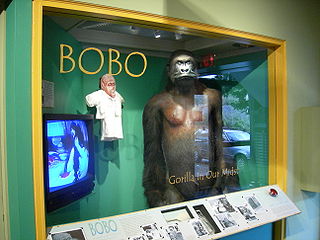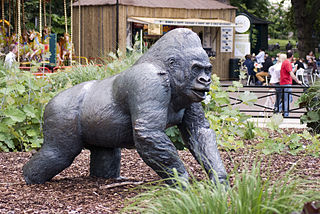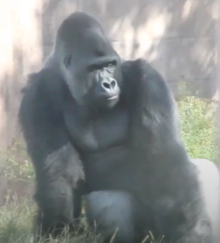
Gorillas are herbivorous, predominantly ground-dwelling great apes that inhabit the tropical forests of equatorial Africa. The genus Gorilla is divided into two species: the eastern gorilla and the western gorilla, and either four or five subspecies. The DNA of gorillas is highly similar to that of humans, from 95 to 99% depending on what is included, and they are the next closest living relatives to humans after chimpanzees and bonobos.
Binti Jua is a female western lowland gorilla in the Brookfield Zoo, in Brookfield, Illinois, outside of Chicago, US. She received media attention after a situation in 1996 in which she tended to a three-year-old boy who had been injured by falling into her enclosure.

The Philadelphia Zoo, located in the Centennial District of Philadelphia on the west bank of the Schuylkill River, is the first true zoo in the United States. It was chartered by the Commonwealth of Pennsylvania on March 21, 1859, but its opening was delayed by the Civil War until July 1, 1874. The zoo opened with 1,000 animals and an admission price of 25 cents. For a brief time, the zoo also housed animals brought to U.S. from safaris by the Smithsonian Institution, which had not yet built its National Zoo.

Woodland Park Zoo is a wildlife conservation organization and zoological garden located in the Phinney Ridge neighborhood of Seattle, Washington, United States. It is the recipient of over 65 awards across multiple categories, and had served approximately 1.4 million domestic and international visitors in 2019.

Werribee Open Range Zoo is an African themed zoo in Werribee, about 32 kilometres (20 mi) south-west of Melbourne, Victoria, Australia. It is part of the Zoological Parks and Gardens Board or Zoos Victoria, which also includes Melbourne Zoo and Healesville Sanctuary. It is situated on approximately 225 hectares and is located on the Werribee River in Werribee Park, adjacent to the Werribee Mansion. It was originally agistment land to the Melbourne Zoo. Werribee Open Range Zoo is home to 360 animals of 40 species as of 2021.

The western lowland gorilla is one of two Critically Endangered subspecies of the western gorilla that lives in montane, primary and secondary forest and lowland swampland in central Africa in Angola, Cameroon, Central African Republic, Republic of the Congo, Democratic Republic of the Congo, Equatorial Guinea and Gabon. It is the nominate subspecies of the western gorilla, and the smallest of the four gorilla subspecies.

Knuckle-walking is a form of quadrupedal walking in which the forelimbs hold the fingers in a partially flexed posture that allows body weight to press down on the ground through the knuckles. Gorillas and chimpanzees use this style of locomotion, as do anteaters and platypuses.

The eastern gorilla is a critically endangered species of the genus Gorilla and the largest living primate. At present, the species is subdivided into two subspecies. There are 6,800 eastern lowland gorillas or Grauer’s gorillas and 1,000 mountain gorillas. Illegal hunting threatens the species.

Bobo (1951–1968) was a western lowland gorilla who was a prominent feature of Woodland Park Zoo in Seattle, Washington, USA, from 1953 until his early death at 17. As a publicly accessible gorilla in the wake of King Kong, Bobo was one of Seattle's most prominent attractions before the construction of the Space Needle and the introduction of professional sports to the city. After his death, Bobo's skin was stuffed and placed on display at Seattle's Museum of History and Industry. The remainder of his body was turned over to the University of Washington's Burke Museum of Natural History and Culture for research purposes; however, the skull went missing shortly after his autopsy and wasn't reunited with the rest of the skeleton until 2007.

Guy the Gorilla (1946–1978) was a western lowland gorilla who was London Zoo's most famous resident and often profiled on children's TV shows and natural history productions. The exact day of Guy's birth was unknown, but the official birthday was set by the Zoo as May 30, and he received large numbers of cards each year.

Harambe was a western lowland gorilla who lived at the Cincinnati Zoo from 2014 to 2016, and previously at the Gladys Porter Zoo for 15 years. On May 28, 2016, a three-year-old boy climbed into a gorilla enclosure at the Cincinnati Zoo and Botanical Garden where he was grabbed and dragged by Harambe. Fearing for the boy's life, a zoo worker shot and killed Harambe. The incident was recorded on video and received broad international coverage and commentary, including controversy over the choice to use lethal force. A number of primatologists and conservationists wrote later that the zoo had no other choice under the circumstances, and that it highlighted the danger of zoo animals near humans and the need for better standards of care.
The Gulf Breeze Zoo is a 50-acre (20 ha) zoo located in Woodlawn Beach, Florida, neighboring Navarre and Gulf Breeze, Florida. It has over 900 exotic animals including rhinos, hippos, Western lowland gorillas, and orangutans that visitors can view during an African preserve train ride. Activities include hand-feeding of some animals including giraffes. The Gulf Breeze Zoo supports captive breeding, wildlife conservation, and habitat preservation programs.
Charles the Gorilla is a wild-born western lowland gorilla from Gabon, West Africa. Although the date of his birth is unknown his approximate date of birth is September 23, 1972; it is, however, celebrated on January 19 each year. At a time when humans were less vigilant about their treatment of threatened and endangered species, Charles was sought after by a group of poachers interested in acquiring gorillas for international trade. He is thought to have been found lying next to the corpse of his dead mother.

Pattycake, also known as Patty Cake was a female western lowland gorilla born to Lulu and Kongo at the Central Park Zoo in New York City. She was the first baby gorilla successfully born in captivity in New York. Months after her much publicized birth, Pattycake's arm was broken when it got stuck in her cage as her mother grabbed her away from her father. The incident was sensationally anthropomorphized in the media as a domestic dispute between Lulu and Kongo, but in reality experts thought it was a simple accident.

Shabani is a male western lowland gorilla, born at the Apenheul Primate Park in the Netherlands, raised in Australia and currently residing at the Higashiyama Zoo in Nagoya, Japan. He gained publicity in 2007 at Higashiyama Zoo when he was 10 years old by tightrope walking.
Kokomo is a female western lowland gorilla that lives in the San Diego Zoo Safari Park. She was moved from the Oklahoma City Zoo to the San Diego Zoo Safari Park. The western lowland gorilla is a Critically Endangered species.
Ndume is a male western lowland gorilla known for having learned a limited amount of a modified version of American Sign Language (ASL) and for being at the center of lawsuit over his custody between the Cincinnati Zoo and the Gorilla Foundation. Ndume has lived most of his life at the Gorilla Foundation's sanctuary at Woodside, California, but has also lived at the Cincinnati Zoo and the Brookfield Zoo. Following a lawsuit, which raged on for months, Ndume was transferred back to the Cincinnati Zoo from the Gorilla Foundation on June 14, 2019.
Michael Stern is an American zookeeper, conservationist, anthropologist and primatologist who serves as the Curator of Primates and Small Mammals at Philadelphia Zoo and is the co-founder of the New Nature Foundation. He previously worked at the Denver Zoo and Honolulu Zoo.
Ozoum, commonly referred to as Ozzie, was an African-born western lowland gorilla who was a subject of research at the Yerkes National Primate Research Center in the U.S. state of Georgia from 1964 until 1988, when he was transferred to Zoo Atlanta. In 2009, he was the first gorilla to "volunteer" for a blood pressure test. Before his death at age 60, he was the oldest recorded male gorilla in captivity.











